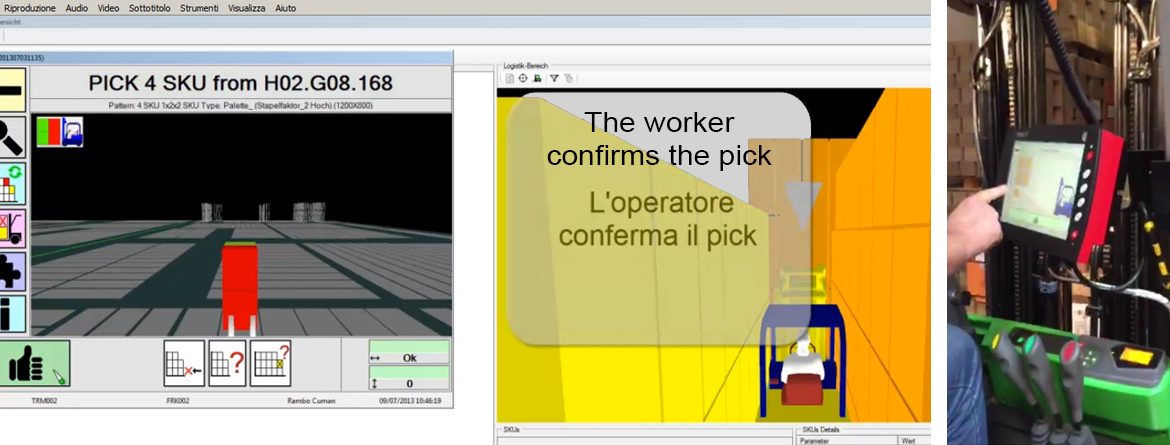A new warehouse management system for Samboro, a top player on the Central American ceramic scene that has chosen the Sacmi-Toyota Material Handling Italia model.
An order and warehouse management revolution that will extend the dream of achieving “just in time” production to the ceramic industry. This, in short, is the goal of Samboro (a major Guatemalan manufacturer and a key player on the Central American ceramic industry), which has chosen the warehouse logistics management model developed by Sacmi-Toyota Material Handling Italia.
The key advantage of this model is that it generates efficiency by minimising warehouse stocks and the time wastage that is innate to traditional order and production process management. Now, one year on from the establishment of a business partnership between the Sacmi Group – the world’s leading producer of ceramic-making machines and plants – and Toyota Material Handling Italia, a specialist in material handling solutions, this model is demonstrating its soundness as a response to changing needs in the ceramic industry: such as the need to produce exactly what the market demands, when and how it requires it, while avoiding storage area “gigantism”, until recently the only way of providing a dynamic response to market needs.
“By taking advantage of Sacmi’s extensive experience in the ceramic sector, the Toyota Academy’s consolidated expertise in process analysis and the Toyota Material Handling Italia Logistic Solutions Division’s design of integrated logistics systems, we’ve succeeded in developing a model for Samboro that responds to one of the most pressing challenges in the ceramic industry, that is, minimising finished product stocks””, explains Stefano Cudicio, a key figure in the Toyota Material Handling Italia Logistics Solutions Division and a member of the Sacmi-Toyota joint workgroup.
Over the last few years, in fact, the utilisation of traditional manufacturing methods and the quest to meet market demand have seen the ceramic industry create storage areas decidedly larger than those dedicated to production, with consequent inefficiencies and higher costs. “The strength and value of the ceramic product”, explains Sacmi Ceramic Division’s Manlio Timoncini, a manager working together with Stefano Cudicio on the joint Sacmi-Toyota workgroup, “lie, and always will lie, in its intrinsic product quality and outstanding aesthetics. That’s why it is essential to gear up from both a technological and organisational standpoint: only then can we deal with the growing dynamism of demand, the ongoing evolution of tastes and the requirements dictated by designer-driven innovation. Only then can we provide personalised, customer-specific differentiated solutions that take cultural contexts and market segments into account”. In other words, there’s a need to deal with ever-shorter ceramic product life-cycles and a market where product development and order management are no longer done how and when the manufacturer wants but only how and when the final customer wants.
But what, in practice, is the model? “The system designed to optimise the logistics of Samboro’s finished product yard”, explain the managers of the joint Sacmi-Toyota Material Handling Italia workgroup, “reduces the number of handling tasks, increases the level of service and cuts management costs”. By overturning traditional order pick and preparation logic, the solution “is based on a `goods to personnel´ concept in which the fork-lift drivers circulate in the storage area and bring the goods to the pick personnel who, instead, remain in the shipment area. This generates efficiency at every level, saving time, cost and space, minimising the errors made at the picking stage and enhancing both safety and traceability throughout the process”.
The model developed for Samboro is part of a true “organisational philosophy” inspired by the Toyota Way, valid, in principle, for a vast range of goods and manufacturing processes (the internationally acclaimed “Toyota Production System”).
Of course, this model has been adapted to the needs and the nature of ceramic manufacturing. More specifically, notes Stefano Cudicio, “we have implemented steep verticality; in other words we’ve adapted to the needs of both production and final customer, a solution already applied successfully in the plastics and food&beverage sectors with the advanced I_Log (Intelligent Logistics) supervision software that interfaces with every single stage of production and order management, providing real-time information on warehouse status”. So, given the adaptability of the model to a variety of situations and technologies, with logistical sub-systems potentially capable of covering the entire process, “the one applied at Samboro – concerning the finished product warehouse – is just the first step, within a broader kaizen approach, in an organisational revolution aimed at establishing fully ‘make to order’ manufacturing, where warehouse stocks are seen as muda (a Japanese term meaning wastefulness) and minimised or even eliminated altogether”.
Sacmi-Toyota Material Handling Italia thus offers top international ceramic manufacturers a solution in which it’s not just cutting-edge machinery and technology that generate value but also the implementation of integrated logistic models: a change that, like all revolutions, starts with people and processes, the efficiency and effectiveness of which inevitably have an impact on product quality and competiveness.
